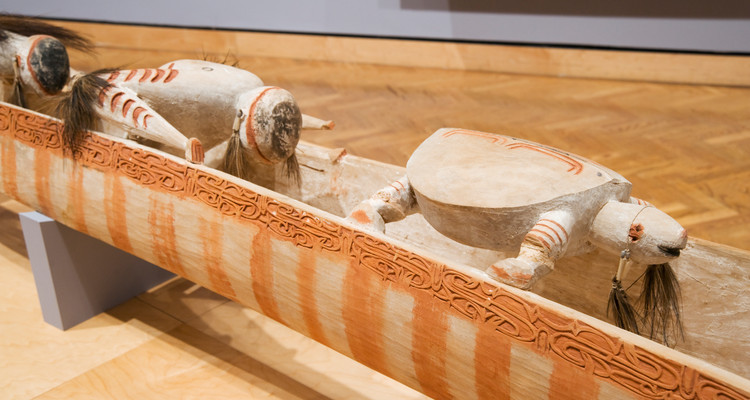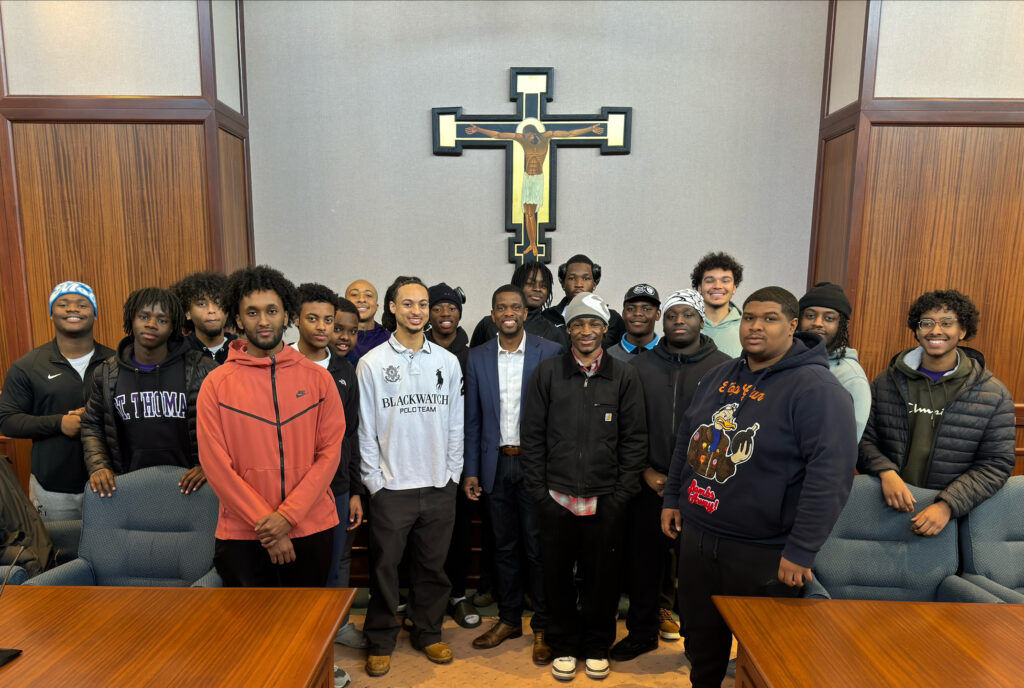If you're standing in the entrance of The Gallery, neatly tucked into the second floor of the Anderson Student Center, you can see nearly every piece of art without stepping inside. The American Museum of Asmat Art’s collection of original artworks from New Guinea has grown to more than 2,000 pieces (from the approximately 1,400 pieces donated by the American Crosier Fathers and Brothers and the Diocese of Agats in 2007), and is now mostly stored in two locations on campus.
The Gallery can only accommodate a fraction of those pieces at any time, so to make sure as much of the collection is seen as possible, two temporary exhibitions are held per year. Each exhibition is themed and requires months of planning, researching, and physically moving and arranging the objects.
Those responsibilities, for the latest exhibit, Sacred Menagerie: Animals in Asmat Art, fell to Eric Kjellgren, the new director of the museum, and his graduate assistants, Jenny Smith and Zachary Forstrom.
Building the menagerie
Kjellgren picked animals in Asmat art because it was a general and accessible theme that allowed for a wide variety of works from the collection to be shown.
“My goal is to get as much seen as possible, given the size of The Gallery and the size of the collection, and the various constraints of showing it,” Kjellgren said.
The exhibit includes a range of objects: from nose ornaments, daggers and shields to 3-D carvings and textiles. The pieces are made from many different materials, including wood, feathers, animal bones, fur, eggs and fiber. Kjellgren thought it important to put both traditional and contemporary artworks into the exhibition.
“One of the things I most wanted to show was the continuity of (animal imagery), past to the present, as well as the way it has evolved from earlier art forms to contemporary ones,” Kjellgren said. He noted that most modern pieces are made for the art market, but still often depict traditional subject matter or episodes from myths.
Many of the animals seen on the works in the exhibition are connected to the former practice of head-hunting. Kjellgren likened the Asmat’s continuing use of head-hunting imagery to Minnesota’s use of Viking imagery.
“We still show people with Viking helmets and swords, even though we don’t go out and raid villages anymore,” Kjellgren said.
Into the collection
Once the theme was selected the research began. Smith did most of that and said finding information can be challenging. Some of the items are well-documented, and Smith can look through original logbooks that came with them, which contain information about the pieces. But some items are not well-documented, which means turning to more general books and “old-fashioned research,” because there’s not much online.

This Asmat carving tells a traditional story of a man being carried off by flying foxes, which are large fruit bats. / M. Jensen
Forstrom added that each area of Papua province in New Guinea has different dialects and myths.
“They’re all very, very distinct," Forstrom said. "One object may have one myth of creation, and another might have a different one. You can’t just start saying universal stuff for any of it.”
For Smith, that made being able to connect a myth with an object they already were looking at particularly rewarding.
While researching, they combed through the collection, selecting objects to display. Kjellgren said it was vital to physically look at each of the objects to know how much space a particular work needs.
"You always really need to look at the object itself to get a real idea of it. Even though we have measurements and the photographs in the database, sometimes it's hard to visualize," Kjellgren said.
Creating a visually appealing space
Then comes one of the more challenging parts: moving the objects and mounting them in The Gallery. Many of the mounts were made by Forstrom, who has worked on previous exhibits at AMAA@UST, the Denver Art Museum and the Minneapolis Institute of Arts. The task of making permanent mounts for larger or more difficult objects is often done by contractors outside of St. Thomas.
Being flexible and improvising is important, Smith said. Some of the objects are fragile. Wood can warp, depending on the humidity, or crack. Forstrom said that even objects that have permanent mounts – such as the spirit canoe that is currently in the middle of The Gallery – shift so they no longer fit just right in their mounts, so the mounts may need to be adjusted periodically. The mounts also can’t be made too tight, and they have to pay attention to which items have stress points when moving them.
Fibers, in particular, Forstrom said, require a lot care because they are a “conservation nightmare.”
“As fibers age, they become brittle," Forstrom said. "In the last exhibition, we had a sago bowl and the thing feels like a potato chip. If you were to squeeze it, it would start breaking or crunching, because it’s made of the fibrous material of the sago plant."
Installing items so they look visually appealing is also important. Kjellgren said that many items don't have straight edges, so that can be a challenge.
"A lot of times, when you put something in a case, you center it visually instead of taking a ruler and measuring it," Smith said. "You want people to think it looks centered." She added that, without straight edges, they also have to make sure every piece is stable.
Forstrom said they wear gloves to help protect the objects from the oils of the human hand and because paint pigment will fleck off.
Another consideration is how – and even if – to clean the objects. Forstrom said they usually use a dry brush for cleaning at AMAA@UST, but there is debate among conservationists on whether to leave the original dirt on a piece.
“Sometimes, it makes sense, because you have an Ancient Egyptian mummy, and there might be something important (to learn) by testing the dirt,” Forstrom said.
The perspective of the guest is carefully considered when the objects are being arranged in The Gallery. Many works are angled toward the entrance and lights are strategically placed on the objects. The space works in other ways that might not be noticeable at first. The colors, including the walls and flooring, were picked to accent Asmat art.
“Asmat has muted colors with the tans and the oranges, but they also have really deep black," Forstrom said. "So if you had a dark background, you’d lose the black. If you had a light one, everything would look sort of muddled. So, this is supposed to be a color chosen specifically so everything still can stand out."
Sacred Menagerie will be on display until July 31. The reception is March 6.
"There's a little bit of New Guinea in Minnesota, so if you're looking for the tropical Pacific in the middle of winter, you can come see the works," Kjellgren said.







